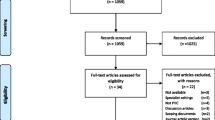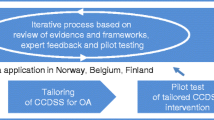Abstract
Clinical practice relies on structured learning that is applied to a patient care setting. Patients present with symptoms and providers try to fit these complaints into known disease categories. Providers depend on memorized algorithms to direct diagnosis and treatment. Well thought-out guidelines developed by professional societies and based on the best available evidence have become the standard in modern medical care. Guidelines are developed to assist practitioners in making appropriate healthcare decisions, to help standardize medical care and improve quality. Guidelines attempt to change practice behavior towards an established norm when evidence is available or toward a consensus opinion when randomized trials are lacking. Patients seeking medical care expect that their practitioner is providing up-to-date, quality medical care. The payors of this care are also interested in quality but must pay attention to medical costs. Both the patient and the payor are invested in providers who use the best available evidence in providing care that is clearly based on guideline development and dissemination.
The American Pain Society (APS) has written three practice guidelines, the most recent of which is the Guideline for the Management of Pain in Osteoarthritis, Rheumatoid Arthritis, and Juvenile Chronic Arthritis, published in 2002. Based on high quality research, when available, and consensus opinion from opinion leaders, these guidelines are endorsed throughout the world’s medical community. Like any other guidelines, the goal is to standardize care and improve quality.
The future will bring more development of guidelines like those from the APS. As studies improve and trials show more effective treatment paradigms, well researched, appropriately designed guidelines will emerge which are structured for busy practices. But this will not be enough; providers need to be made aware of the guidelines, educated on their use, shown appropriate studies documenting efficacy, given simple strategies to implement these guidelines, repeatedly reminded of the appropriate care and, finally, monitored for compliance. For guidelines to be effective they must be tested, disseminated, and their impact on healthcare outcomes must be assessed.
Payors want evidence of the value for their expenditures and guidance by professional societies in allocating limited resources. At the same time, payors are struggling with quality issues. Guidelines can help standardize care that may also be more cost effective as well as satisfy quality concerns from regulatory agencies and the public. Understanding where guidelines make an impact and why resistance develops to well meaning, expert based documents will help us in our disease management efforts.


Similar content being viewed by others
References
Field MJ, Lohr KN, editors. Clinical practice guidelines, directions for a new program. Washington, DC: National Academy Press, 1990
Bigos S, Bowyer O, Braeng G, et al. Acute low back problems in adults: clinical practice guideline No. 14. Rockville (MD): Health Care Policy and Research, Public Health Service, US Department of Health and Human Services, 1994 Dec
American Pain Society. Principles in analgesic use in the treatment of acute pain and cancer pain. 5th ed. Glenview (IL): American Pain Society, 2003
American Pain Society. Guideline for the management of acute and chronic pain in sickle cell disease. Glenview (IL): American Pain Society, 1999
American Pain Society. Guideline for the management of pain in Osteoarthritis, rheumatoid arthritis and juvenile chronic arthritis. 2nd ed. Glenview (IL): American Pain Society, 2002
Spitzer WO, Leblanc FE, Dupuis M, et al. Scientific approach to the assessment and management of activity-related spinal disorders. A monograph for clinicians: report of the Quebec Task Force on Spinal Disorders. Spine 1987; 12 Suppl.: S1–S59
Nuffield Institute for Health, Centre for Health Economics and the NHS Centre for Reviews and Dissemination, Royal College of Physicians. Effective health care: implementing clinical practice guidelines. Leeds: University of Leeds, 1994
Medical Review Division, Texas Workers’ Compensation commission. Spine treatment guidelines. Dallas (TX): Texas Workers’ Compensation Commission, 1994
WorkCover Corporation. Guidelines for the management of back injured employees. Adelaide (SA): WorkCover Corporation, 1993
Industrial Insurance Advisory Committee. Washington State Medical Association: guidelines for lumbar fusion (arthrodesis). Seattle (WA), 1993
Rosen M, editor. Back pain: report of a CSAG Committee on back pain. London: HMSO, 1994
Di Iorio D, Henley E, Doughty A. A survey of primary care physician practice patterns and adherence to acute low back problem guidelines. Arch Fam Med 2000; 9: 1015–21
Cherkin DC, Wheeler KJ, Barlow W, et al. Medication use for low back pain in primary care. Spine 1998; 23: 607–14
Eccles M, McColl E, Steen N, et al. Effect of computerized evidence based guidelines on management of asthma and angina in adults in primary care: cluster randomized controlled trial. BMJ 2002; 325: 941–58
Negrini S, Politano E, Carabalona R, et al. General practitioners’ management of low back pain: impact of clinical guidelines in a non-English-speaking country. Spine 2001; 26: 2727–33
Rao JK, Kroenke K, Mihaliak KA, et al. Can guidelines impact the ordering of magnetic resonance imaging studies by primary care providers for low back pain? Am J Manag Care 2002; 8: 27–35
Tierney WM, Miller ME, McDonald CJ. The effect on test ordering of informing physicians of the charges of outpatient diagnostic test. N Engl J Med 1990; 322: 1499–504
Tierney WM, McDonald CJ, Hui SL, et al. Computer predictions of abnormal test results: effects on outpatient testing. JAMA 1988; 259: 1194–8
Bree RL, Kazerooni EA, Katz SJ. Effect of mandatory radiology consultation on inpatient imaging use: a randomized controlled trial. JAMA 1996; 276: 1595–8
Williams SV, Eisenberg JM. A controlled trial to decrease the unnecessary use of diagnostic tests. J Gen Intern Med 1986; 1: 8–13
Freeborn DK, Shye D, Mullooly JP, et al. Primary care physicians’ use of lumbar spine imaging tests: effects of guidelines and practice pattern feedback. J Gen Intern Med 1997; 12: 619–25
Ferrell BR, Griffith H. Cost issues related to pain management: report from the cancer pain panel of the Agency for Health Care Policy and Research nursing strategies to improve cancer and decrease costs of admissions. J Pain Symptom Manage 1994; 9: 221–34
Katz DA, Griffith JL, Beshansky JR, et al. The use of empiric clinical data in the evaluation of practice guidelines for unstable angina. JAMA 1996; 276: 1568–74
Suarez-Almazor ME, Belseck E, Russell AS, et al. Use of lumbar radiographs for the early diagnosis of low back pain: proposed guidelines would increase utilization. JAMA 1997; 277: 1782–6
Cherkin DC, Deyo RA, Wheeler K, et al. Physicians’ views about treating low back pain: the results of a national survey. Spine 1995; 20: 1–10
Little P, Smith L, Cantrell T, et al. General practitioners’ management of acute low back pain: a survey of reported practice compared with clinical practice guidelines. BMJ 1996; 312: 485–8
Scroth WS. Practice guidelines in primary care: abstract, executive summary and final report. Rockville (MD): US Dept of Health and Human Services, Public Health Services, Agency for Health Care Policy and Research, 1996 Aug
Aetna US HealthCare. Coverage policy bulletin #45 [online]. Available from URL: http://www.aetna.com.index.htm
Acknowledgements
The author did not receive any funding for this review and has no conflicts of interest directly relevant to the content of this review.
Author information
Authors and Affiliations
Corresponding author
Rights and permissions
About this article
Cite this article
McCarberg, B. Impact of Guidelines on Healthcare from the Patient and Payor Perspective. Dis-Manage-Health-Outcomes 12, 73–79 (2004). https://doi.org/10.2165/00115677-200412020-00001
Published:
Issue Date:
DOI: https://doi.org/10.2165/00115677-200412020-00001




